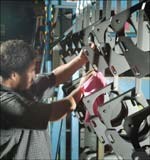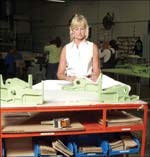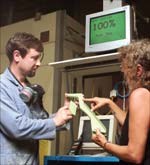Expecting The Unexpected
When Murphy's Law "unexpectedly" delivered five critical parts for simultaneous finishing, instead of the usual one or two, they were processed quickly and without breaking a sweat. Explanation—this supply chain had planned for contingencies everyone agreed would "probably" never materialize...
In the continuous improvement marathon, companies that pause to catch their breath are often left in the dust. Permanently. That's what makes the practices of Alcoa Prime Services (APS), a unit of Alcoa Howmet Castings headquartered in Whitehall, MI, so instructive. APS was established to supply OEMs with finished-to-print, ready-to-assemble components. Industry trends had presented Howmet with an option: Remain a first-tier supplier and watch certain types of business from leading customers erode, or become a systems integrator, breaking with decades of tradition, to do whatever it takes to satisfy customers—including managing the full range of finishing operations.
Howmet chose to become a systems integrator, providing third-party-logistics services to a growing list of customers that wanted them, using leading, non-Howmet finishing organizations whenever an advantage in speed, cost, quality or responsiveness could be captured or created.
According to Gary Zakrzeski, Howmet's director of sales and marketing for specialty businesses, APS's strategy for satisfying customers is to follow the principals of the Alcoa Business System (ABS). “ABS is a toolkit of business best practices that eliminate waste on an enterprise-wide basis, not just in production. So when we have a customer requirement that confronts us with a waste of any kind—time, cost, scrap, non-value-added steps, anything—that can be eliminated by working with a specialized finisher, we bring that finisher into our supply chain. Our objective is to find and leverage the aggregate expertise of the very best suppliers, so we can offer customers a level of service and benefits they can't get inside—or anywhere else outside—their company.”
This approach has created an opportunity for operations like Hytek Finishes, based in Kent, WA. The largest independent supplier of plating, anodizing and organic coating services in the Pacific Northwest, Hytek is part of the Advanced Materials Group of Esterline Technologies, a company that promotes lean manufacturing as a way of life. “Part of Hytek's appeal to APS is our comprehensive approach to continuous improvements, especially planning ahead,” says Clifton Johnson, president of Hytek Finishes. “We benefit from our parent company's support for continuous improvement, so we are able to keep pace with expectations by investing in the resources we need to satisfy customers. This approach has led to steady growth.”
Zakrzeski says, “Typically, to win business we have to provide order-of-magnitude cost savings, as well as delivery that is both faster and more reliable than the customer is currently receiving internally or from another outside supply chain. Quality is always a given. That's why the intangibles are so critical when picking a finisher to bring onto the supply-chain team.”
Zakrzeski says APS has grown its customer base from three to 13 major, global OEMs over the last four years and that the operation carefully explores the fit between APS and candidates for supply-chain membership. “We look for compatibility of approach. In the case of Hytek, they have an established lean manufacturing culture, which aligns nicely with the Alcoa Business System, indicating to us that we share a common point of view on problem solving and running our businesses. We look at attitude of service to end-customers. Hytek and APS can point to a documented track record of continuous-improvement results that show real progress in areas that matter to customers.” However, Zakrzeski adds, having installed a suite of best practices and proving the organization is dedicated to continuous improvement are the minimum requirements for today's successful supply chain. “Perhaps more important is testing for organizational ‘chemistry.' Will two organizations be able to develop a relationship of trust and demonstrate that they can work together effectively long term? That's the fundamental question we're asking today,” he says.
The test for organizational “chemistry” includes two main areas according to Zakrzeski. “First, how collaborative can we be? We will succeed in working together by openly sharing information so we can align our practices and objectives. That means we'll have to be committed to each other's success. And second, how willing will both parties be to make needed changes that will benefit the supply chain's ability to improve performance?” Zakrzeski asks.
Elements of Supply Chain Success
- Compatibility of Approach
- Attitude of Service
- Organizational Chemistry
- Collaborative Focus
- Willingness to Change
Johnson can point to a broad array of continuous improvement results, such as doubling Hytek's customer base without increasing the square footage the operation has had since 1988, as well as reducing cycle time by 40% on the key part the organization finishes for APS, and cutting unplanned overtime by more than 10% during the last 12 months.
“There are two reasons why Hytek has to keep getting better. One, it's the price for staying in the game with top customers, and two, we're the last stop for 95% of the parts we finish. That means we have high visibility to customers, so we really try to perform better tomorrow than we did today, because if anything can go wrong, it will. We know from experience,” says Johnson.
To keep getting better, Johnson lists a number of key activities at Hytek. The first is continuous improvement. “We want employees talking and thinking. This is the key element in creating an environment where continuous improvement is a reality, not just something you tell customers you do. We empower people. We tell them we need their help solving problems with innovative thinking. Then we educate them about lean manufacturing techniques and promote cross training with a skill-based wage program. This program not only offers those who take advantage of it a chance for faster advancement, it makes sure Hytek is covered across many different skill levels and operational shifts.”
Does this approach work?
Johnson says it does. Hytek recently demonstrated it could walk the continuous improvement walk, as well as talk it and that it could handle the unexpected. “Recently, five large aerospace components of the type we handle for APS came into the shop at the same time. We are now committed to shipping each part in five days, but never expected there would be more than one or two in the shop in any given week. With the arrival of five components, we faced a moment of truth.”
The titanium parts, which are more than 48 inches long and weigh approximately 350 lbs, presented an array of challenges to Hytek. Fortunately, the organization was ready to meet those challenges. “Our entire team had preplanned for this eventually when we were awarded the business more than a year ago.”
Howmet's Zakrzeski says the stack up of work is a problem the entire supply chain shares, not just one link. “We make sure Hytek knows what's coming as soon as we ourselves know—at least a couple of days before parts arrive. That gives them time to arrange their schedule to accommodate the parts.”
Hytek's Johnson says advance information about parts makes a big difference. “We have a very responsive system, but if we get blindsided by work arriving without forewarning, it can disrupt our schedule and create the need for unplanned overtime. However, with a few days notice, we can now integrate even the largest, most complex finishing tasks into the flow without missing a beat.”
On APS's end, thanks to the unit's recently upgraded order-entry system, the customer service department has cut order-entry cycle time 75%. On Hytek's end, continuous improvement focused on the 350-pound titanium components it processes for APS. Efforts in this area have trimmed cycle time from five to eight days, a 40% improvement.
Nonetheless, the arrival of five parts in the same scheduling time frame might have overwhelmed another finisher. But not Hytek.
“Our ability to handle unexpected volumes grows out of the way we apply lean manufacturing techniques. First, we set up our continuous improvement process to include all the worst-case scenarios we can imagine current and prospective customers throwing at us. Next, we tell our people we expect a lot of thinking and innovation from them to anticipate and plan for these different scenarios. These two fundamentals paid off for us with the aerospace part we finish for APS,” says Johnson.
Johnson points to employee ideas that were incorporated throughout the process. These included modifications to the transfer tables, or carts, that move the heavy, asymmetrical parts from station to station. When Hytek designed these carts, the maintenance department, which built them, added an improved lifting device so the 350-pound part could be loaded, unloaded and manipulated for inspection much more quickly and easily. “They also suggested we make a second cart,” adds Johnson.
The cleaning department, made up of a collection of tanks in which parts are etched before priming and painting, underwent an upgrade a few years ago. When it was re-engineered, the department's layout, size and number of tanks were all modified based on best estimations of future customer needs. “We factored in the increasing size of some of the parts we were working on and the potential need to process a number of them at once,” says Johnson.
It was also in this area that Hytek's commitment to cross training paid dividends. “A key employee in the titanium department had already been trained as a masker. So when the APS part, with its close-tolerance holes, came through for etching, our employee knew how to quickly and properly plug the holes and get the part right into the process,” says Johnson.
The same habits of planning and innovation have impacted the tables that convey the part through the paint department. “Customized fixturing, designed and built in-house, allows us to rotate the part during the paint process. This innovation has helped us to accelerate throughput,” Johnson says.
As part of the process of planning for the unexpected, Hytek decided to manufacture two extra paint tables. “The result was that, when the five parts were in process all at once, we were able to have two on the transfer tables moving into or out of inspection, etch or fluorescent penetrant inspection, while the other three were in various stages of the priming and painting process. The five parts were virtually always in motion. There was never a stop in the flow due to queue-and-wait time because we didn't have material handling equipment or skilled people to keep things moving,” Johnson says.
According to Zakrzeski, both APS's and Hytek's approach to supply chain management is process-oriented.
“We are constantly looking for ways to accelerate the flow of material and information. To that end, Hytek is currently exploring an arrangement that would eliminate a time-consuming stop in the routing by consolidating a critical inspection step in their Kent, WA plant. At APS, we are rolling out an information system that, one day soon, will connect every link in supply chain, in real time, to the status of every piece of work-in-process inventory. Together, APS and Hytek are constantly seeking ways to optimize the deployment of supply chain assets to the greater benefit of customers. Getting continuously better at doing this will be the key to the on-going success of our entire supply chain, as measured by sales growth and customer satisfaction,” Zakrzeski says.
Related Content
Nanotechnology Start-up Develops Gold Plating Replacement
Ag-Nano System LLC introduces a new method of electroplating based on golden silver nanoparticles aimed at replacing gold plating used in electrical circuits.
Read MoreProducts Finishing Reveals 2023 Qualifying Top Shops
Each year PF conducts its Top Shops Benchmarking Survey, offering shops a tool to better understand their overall performance in the industry. The program also recognizes shops that meet a set of criteria to qualify as Top Shops.
Read MoreHow to Choose Between Sulfate and Chloride-Based Trivalent Chromium
There are several factors to consider when choosing between sulfate and chloride-based baths for trivalent chromium plating. Mark Schario of Columbia Chemical discusses the differences and what platers should keep in mind when evaluating options.
Read MoreProducts Finishing Reveals 2024 Qualifying Top Shops
PF reveals the qualifying shops in its annual Top Shops Benchmarking Survey — a program designed to offer shops insights into their overall performance in the industry.
Read MoreRead Next
Episode 45: An Interview with Chandler Mancuso, MacDermid Envio Solutions
Chandler Mancuso, technical director with MacDermid Envio discusses updating your wastewater treatment system and implementing materials recycling solutions to increase efficiencies, control costs and reduce environmental impact.
Read MoreEducation Bringing Cleaning to Machining
Debuting new speakers and cleaning technology content during this half-day workshop co-located with IMTS 2024.
Read MoreDelivering Increased Benefits to Greenhouse Films
Baystar's Borstar technology is helping customers deliver better, more reliable production methods to greenhouse agriculture.
Read More















.jpg;maxWidth=300;quality=90)










